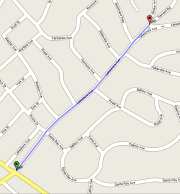If you bicycle, you know that bike lanes create space on the streets that help cyclists and drivers share the road. They make it safer and more comfortable for bicyclists and thereby encourage more people to leave their cars at home, especially for short trips.
But if you don’t bicycle, why should you care about bike lanes?
To put it briefly, bike lanes are good for neighborhoods because they help streets work better.
Consider the proposal now under discussion to reconfigure Lakeshore Avenue from Mandana Blvd. to Harvard Road/Winsor Avenue. Currently, the street has four travel lanes, two in each direction, plus parallel parking on both sides. The proposal is to re-stripe the street with one travel lane in each direction, a two-way center turn lane, and bike lanes in both directions. The current parallel parking would stay just as it is.
This proposal arises from longstanding community concerns that the current four lanes encourage speeding, compromise pedestrian safety, and aren’t compatible with the residential character of the neighborhood. And a sewer rehabilitation project scheduled for this winter creates an opportunity to reconfigure the lane striping on the street at little to no additional cost.
These projects are commonly called “road diets” because they take wider streets and make them narrower (without the expense of literally moving the curbs). The bike lanes soak up the extra width and create buffers that improve both safety and operations. These projects are sometimes called “bike projects” but they are really neighborhood projects because of the following benefits:
- Safer walking: On such a street, pedestrians cross only two travel lanes instead of four. This configuration eliminates what are called “multiple threat” collisions on four-lane streets: when the driver in the first lane yields but the driver in the second lane doesn’t because the pedestrian is hidden behind the stopped car. Additionally, bike lanes create an additional buffer between the sidewalk and the travel lanes such that drivers and pedestrians both have more time to react. These pedestrian safety benefits are especially fitting for the school crossing on Lakeshore Avenue at Prince Street that serves the Mandana Green.
- Safer driving: With a two-way center turn lane, drivers making left turns no longer stop in a travel lane and run the risk of rear-end collisions. Providing this lane for turning vehicles avoids these types of collisions while helping traffic move more smoothly.
- Safer parking: Whether parking at the curb or in a driveway, the bike lane creates a buffer between the parking area and the travel lane that improves visibility and helps motorists maneuver. (However, always remember to check for bicyclists before opening a car door.)
- Lower speeds: With two travel lanes in each direction, the fastest driver sets the speed. With one travel lane in each direction, the safe driver sets the speed and everyone else drives the speed limit behind that person. This is an example of a design that is self-enforcing and thus encourages safe behavior.
- Less noise: Lower speeds mean less noise, an especially important issue for people with homes (and bedrooms) on busier streets.
Who doesn’t benefit from such a project? Those would be the people who want to speed through other people’s neighborhoods.
And by the way, bike lanes do make it safer, easier, and more enjoyable for cyclists to get around town along with all the other environmental and public health benefits of bicycling. They even encourage people to bicycle, with the added benefit of getting more neighbors out and about.
For additional information on the Lakeshore Ave project (Mandana Blvd. to Harvard Road/Winsor Ave.), contact Joanne Karchmer (JKarchmer@oaklandnet.com, 238-7021) in the office of Councilmember Pat Kernighan. For more information on bicycle-related projects in Oakland, see www.oaklandpw.com/bicycling.






Comments